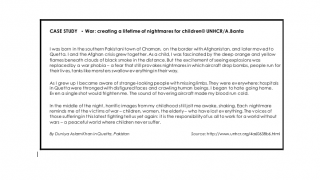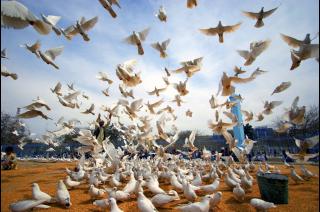What is peace?
In many ways ‘peace’ is a fairly new concept. In the past, every generation all over the world - and in Europe in particular - had ‘its’ war. War was considered almost inevitable and peace a vague utopian dream. But the horrors of World War one and World War two with a death toll of 9 million and 55 million respectively, brought home the global need to broker a solution which would favour peace over war. It was out of this shared interest in creating a forum for discussion and standards that would be respected internationally that the UN was founded.
- In 2008 a ceasefire was held in Afghanistan on International Peace Day. Ceasefires provide civilians enduring the hardships of conflict a welcome respite and give aid workers the chance to reach those in need of help, medication and food.
Every year the Secretary General gives a speech to mark the importance of peace day and to underline the UN’s continued role in maintaining peace and efforts towards the global disarmament of weapons. But peace is not only about building peace between nations but bringing peace into our homes. Anyone, anywhere can light a candle, and celebrate it in their own way.
The other side of the coin/How many countries are affected by conflict?
Many countries today are still affected by the ravages of war. There are many types of conflicts, with diverse origins and numerous consequences. Conflicts can occur among States or, even within the same State.
- In 2009 it was estimated that 365 political conflicts in the world, 31 of which were categorised as highly violent conflicts.
- There has been no conflict in Western Europe since 1945, making it the longest period of peace since Roman times
Sources of conflict can be ethnic, religious or environmental in nature or be due to illiteracy or the unequal sharing of resources natural resources, including water, oil or diamonds (e.g. Sierra Leone). Indeed, poverty, the depletion of the natural and economic resources of States, the weakness of political institutions, and human rights violations are some of the major causes of internal conflicts.
Sustained peace equals sustainable development
Conflict have untold repercussions which are devastating on the economic and social dynamic of a country. There is not only the financial cost, but the human cost of lives, the physical and psychological damage and the rupture of communities.
- The total number of people displaced within their country of origin as a result of armed conflict is estimated at 26 million
- Global military spending totaled $1.464 trillion which is just less than the economic output of all the countries in South Asia combined.
Countries in which there is continued peace have the opportunity to develop links, shared interests and long term objectives which allow sustainable growth and development. This is reinforced by increased trade, cooperation and peace between neighboring nations; reduced hunger and poverty and a more stable population.
The UN - working for peace
The UN employs a wide range of tools to promote peace, their use dependant on the circumstances of the country. In places where there is open or simmering conflict, the UN employs tools ranging from mediation to the dispatch of peacekeeping forces. In times of international crisis, it serves as a focal point for easing tensions and beginning negotiations. The UN also promotes peace through a growing body of international law, as well as through development assistance.
- Seventy per cent of the work of the UN system is devoted to helping countries build the capacity to help themselves.
- The Nobel Peace Prize has been awarded to the UN five times since the prize was founded in 1901.
In the preventative sphere, the UN works to heal the economic and social causes of war and aims towards creating ‘sustainable or long-lasting peace’. A forum for diplomacy and debate, the UN also provides a framework for the peaceful settlement of disputes, a means of defusing conflicts before they begin. As part of these operations the concept of peacebuilding has been developed. Peacebuilding operations are not the same as peacekeeping as it works to create a long-term culture of peace, rather than solving existing conflicts or preventing old ones from re-occurring.

What are the plans for the future?
In 2007, a new intergovernmental advisory body that supports peace efforts in countries emerging from conflict was established. This UN Peacebuilding Commission is a key addition to the capacity of the International Community in the broad peace agenda. The resolutions that established the Peacebuilding Commission also provided for the establishment of a Peacebuilding Fund and Peacebuilding Support Office.
For more information, visit www.internationaldayofpeace.org

